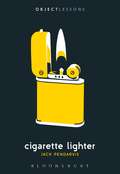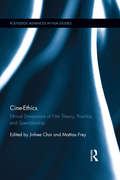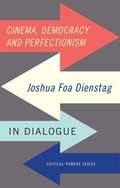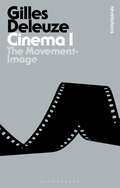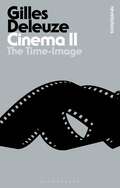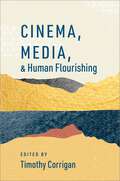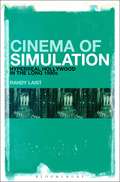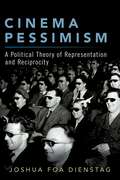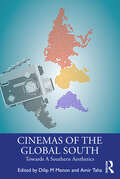- Table View
- List View
Cigarette Lighter (Object Lessons)
by Jack PendarvisObject Lessons is a series of short, beautifully designed books about the hidden lives of ordinary things. Smokers, survivalists, teenagers, collectors…. The cigarette lighter is a charged, complex, yet often entirely disposable object that moves across these various groups of people, acquiring and emitting different meanings while always supplying its primary function, that of ignition. While the lighter may seem at first a niche object-only for old fashioned cigarette smokers-in this book Jack Pendarvis explodes the lighter as something with deep history, as something with quirky episodes in cultural contexts, and as something that dances with wide ranging taboos and traditions. Pendarvis shows how the lighter tarries with the cheapest ends of consumer culture as much as it displays more profound dramas of human survival, technological advances, and aesthetics.Object Lessons is published in partnership with an essay series in the The Atlantic.
Cigarette Lighter (Object Lessons)
by Jack PendarvisObject Lessons is a series of short, beautifully designed books about the hidden lives of ordinary things. Smokers, survivalists, teenagers, collectors…. The cigarette lighter is a charged, complex, yet often entirely disposable object that moves across these various groups of people, acquiring and emitting different meanings while always supplying its primary function, that of ignition. While the lighter may seem at first a niche object-only for old fashioned cigarette smokers-in this book Jack Pendarvis explodes the lighter as something with deep history, as something with quirky episodes in cultural contexts, and as something that dances with wide ranging taboos and traditions. Pendarvis shows how the lighter tarries with the cheapest ends of consumer culture as much as it displays more profound dramas of human survival, technological advances, and aesthetics.Object Lessons is published in partnership with an essay series in the The Atlantic.
Cine-Ethics: Ethical Dimensions of Film Theory, Practice, and Spectatorship (Routledge Advances in Film Studies)
by Jinhee Choi Mattias FreyThis volume looks at the significance and range of ethical questions that pertain to various film practices. Diverse philosophical traditions provide useful frameworks to discuss spectators’ affective and emotional engagement with film, which can function as a moral ground for one’s connection to others and to the world outside the self. These traditions encompass theories of emotion, phenomenology, the philosophy of compassion, and analytic and continental ethical thinking and environmental ethics. This anthology is one of the first volumes to open up a dialogue among these diverse methodologies. Contributors bring to the fore some of the assumptions implicitly shared between these theories and forge a new relationship between them in order to explore the moral engagement of the spectator and the ethical consequences of both producing and consuming films
Cine-Ethics: Ethical Dimensions of Film Theory, Practice, and Spectatorship (Routledge Advances in Film Studies)
by Jinhee Choi Mattias FreyThis volume looks at the significance and range of ethical questions that pertain to various film practices. Diverse philosophical traditions provide useful frameworks to discuss spectators’ affective and emotional engagement with film, which can function as a moral ground for one’s connection to others and to the world outside the self. These traditions encompass theories of emotion, phenomenology, the philosophy of compassion, and analytic and continental ethical thinking and environmental ethics. This anthology is one of the first volumes to open up a dialogue among these diverse methodologies. Contributors bring to the fore some of the assumptions implicitly shared between these theories and forge a new relationship between them in order to explore the moral engagement of the spectator and the ethical consequences of both producing and consuming films
Cinema After Deleuze (Deleuze Encounters)
by Richard RushtonCinema After Deleuze offers a clear and lucid introduction to Deleuze's writings on cinema which will appeal both to undergraduates and specialists in film studies and philosophy. The book provides explanations of the many categories and classifications found in Deleuze's two landmark books on cinema and offers assessments of a range of films, including works by John Ford, Sergei Eisenstein, Alfred Hitchcock, Michelangelo Antonioni, Alain Resnais and others. Contemporary directors such as Steven Spielberg, Lars von Trier, Martin Scorsese and Wong Kar-wai are also examined in the light of Deleuze's theories, thus bringing Deleuze's writings on cinema right up to date. Cinema After Deleuze demonstrates why Deleuze is rightly considered today to be one of the great philosophers of cinema. The book is essential reading for students in philosophy and film studies alike.
Cinema After Deleuze (Deleuze Encounters)
by Richard RushtonCinema After Deleuze offers a clear and lucid introduction to Deleuze's writings on cinema which will appeal both to undergraduates and specialists in film studies and philosophy. The book provides explanations of the many categories and classifications found in Deleuze's two landmark books on cinema and offers assessments of a range of films, including works by John Ford, Sergei Eisenstein, Alfred Hitchcock, Michelangelo Antonioni, Alain Resnais and others. Contemporary directors such as Steven Spielberg, Lars von Trier, Martin Scorsese and Wong Kar-wai are also examined in the light of Deleuze's theories, thus bringing Deleuze's writings on cinema right up to date. Cinema After Deleuze demonstrates why Deleuze is rightly considered today to be one of the great philosophers of cinema. The book is essential reading for students in philosophy and film studies alike.
Cinema and Agamben: Ethics, Biopolitics and the Moving Image
by Asbjorn Gronstad Henrik GustafssonCinema and Agamben brings together a group of established scholars of film and visual culture to explore the nexus between the moving image and the influential work of Italian philosopher Giorgio Agamben. Including two original texts by Agamben himself, published here for the first time in English translation, these essays facilitate a unique multidisciplinary conversation that fundamentally rethinks the theory and praxis of cinema. In their resourceful analyses of the work of artists such as David Claerbout, Jean-Luc Godard, Philippe Grandrieux, Michael Haneke, Jean Rouch, and others, the authors put to use a range of key concepts from Agamben's rich body of work, like biopolitics, de-creation, gesture, potentiality and profanation. Sustaining the eminently interdisciplinary scope of Agamben's writing, the essays all bespeak the importance of Agamben's thought for forging new beginnings in film theory and for remedying the elegiac proclamations of the death of cinema so characteristic of the current moment.
Cinema and Agamben: Ethics, Biopolitics and the Moving Image
by Asbjorn Gronstad Henrik GustafssonCinema and Agamben brings together a group of established scholars of film and visual culture to explore the nexus between the moving image and the influential work of Italian philosopher Giorgio Agamben. Including two original texts by Agamben himself, published here for the first time in English translation, these essays facilitate a unique multidisciplinary conversation that fundamentally rethinks the theory and praxis of cinema. In their resourceful analyses of the work of artists such as David Claerbout, Jean-Luc Godard, Philippe Grandrieux, Michael Haneke, Jean Rouch, and others, the authors put to use a range of key concepts from Agamben's rich body of work, like biopolitics, de-creation, gesture, potentiality and profanation. Sustaining the eminently interdisciplinary scope of Agamben's writing, the essays all bespeak the importance of Agamben's thought for forging new beginnings in film theory and for remedying the elegiac proclamations of the death of cinema so characteristic of the current moment.
Cinema and Sacrifice (Angelaki: New Work in the Theoretical Humanities)
by Costica Bradatan Camil Constantin UngureanuCinema has a long history of engaging with the theme of sacrifice. Given its capacity to stimulate the imagination and resonate across a wide spectrum of human experiences, sacrifice has always attracted filmmakers. It is on screen that the new grand narratives are sketched, the new myths rehearsed, and the old ones recycled. Sacrifice can provide stories of loss and mourning, betrayal and redemption, death and renewal, destruction and re-creation, apocalypses and the birth of new worlds.The contributors to this volume are not just scholars of film but also students of religion and literature, philosophers, ethicists, and political scientists, thus offering a comprehensive and interdisciplinary approach to the relationship between cinema and sacrifice. They explore how cinema engages with sacrifice in its many forms and under different guises, and examine how the filmic constructions, reconstructions and misconstructions of sacrifice affect society, including its sacrificial practices.This book was originally published as a special issue of Angelaki: journal of the theoretical humanities.
Cinema and Sacrifice (Angelaki: New Work in the Theoretical Humanities)
by Costica Bradatan and Camil UngureanuCinema has a long history of engaging with the theme of sacrifice. Given its capacity to stimulate the imagination and resonate across a wide spectrum of human experiences, sacrifice has always attracted filmmakers. It is on screen that the new grand narratives are sketched, the new myths rehearsed, and the old ones recycled. Sacrifice can provide stories of loss and mourning, betrayal and redemption, death and renewal, destruction and re-creation, apocalypses and the birth of new worlds.The contributors to this volume are not just scholars of film but also students of religion and literature, philosophers, ethicists, and political scientists, thus offering a comprehensive and interdisciplinary approach to the relationship between cinema and sacrifice. They explore how cinema engages with sacrifice in its many forms and under different guises, and examine how the filmic constructions, reconstructions and misconstructions of sacrifice affect society, including its sacrificial practices.This book was originally published as a special issue of Angelaki: journal of the theoretical humanities.
Cinéma brut: Eine alternative Genealogie der Filmavantgarde (Edition Angewandte)
by Gabriele JutzBis heute schwingt im Begriff der Filmavantgarde der Gedanke mit, ein Film sei umso avantgardistischer, je „reiner" er sei - je mehr er seine medienspezifische Bedingtheit, seine "Essenz" inszeniere und sich von anderen Künsten „befreie". Diesem modernistischen Diskurs des Purismus, der sich auch in der aktuellen post-medium condition hartnäckig hält, antwortet die vorliegende Studie mit einer alternativen Phänomenologie und Genealogie des Avantgardefilms, die nicht das Reine, sondern das „Unreine" zum Maßstab nimmt. Mit der expanded-cinema-Aktion, dem handmade- und dem found-footage-Film stellt die Autorin dem cinéma pur ein cinéma brut gegenüber, dessen Dispositive und Praktiken sich am Schmutzigen, an Formverlust und Grenzüberschreitung orientieren. Ausgehend von kunst- und kulturtheoretischen Debatten um Materialität und Performanz, Index und Spur, werden zunächst Grundzüge des cinéma brut systematisiert, und in einem zweiten Schritt, anhand exemplarischer Analysen, Eckpunkte einer „unreinen" Geschichte der europäischen und nordamerikanischen Filmavantgarde markiert.
Cinema, democracy and perfectionism: Joshua Foa Dienstag in dialogue
by Joshua Foa DienstagJoshua Foa Dienstag engages in a critical encounter with the work of Stanley Cavell on cinema, focusing skeptical attention on the claims made for the contribution of cinema to the ethical character of democratic life.
Cinema, democracy and perfectionism: Joshua Foa Dienstag in dialogue (PDF)
by Joshua Foa DienstagJoshua Foa Dienstag engages in a critical encounter with the work of Stanley Cavell on cinema, focusing skeptical attention on the claims made for the contribution of cinema to the ethical character of democratic life.
Cinema I: The Movement-Image (Bloomsbury Revelations)
by Gilles DeleuzeGilles Deleuze was one of the most influential figures in twentieth-century philosophy, well known for his works on the philosophy of art and for his master-works, Difference and Repetition and - with Felix Guattari - A Thousand Plateaus and Anti-Oedipus.Cinema I is the first volume of Deleuze's revolutionary work on the theory of cinema (concluded in Cinema II, also available in the Bloomsbury Revelations series). Drawing on the philosophy of Henri Bergson, Deleuze identified his work as “a logic of the cinema”, setting out to “isolate certain cinematographic concepts” philosophically. To do this, he brings together diverse examples from a variety of major filmmakers, including Ingmar Bergman, Charlie Chaplin, Sergei Eisenstein and Alfred Hitchcock, among many others.
Cinema I: The Movement-Image (Bloomsbury Revelations)
by Gilles DeleuzeGilles Deleuze was one of the most influential figures in twentieth-century philosophy, well known for his works on the philosophy of art and for his master-works, Difference and Repetition and - with Felix Guattari - A Thousand Plateaus and Anti-Oedipus.Cinema I is the first volume of Deleuze's revolutionary work on the theory of cinema (concluded in Cinema II, also available in the Bloomsbury Revelations series). Drawing on the philosophy of Henri Bergson, Deleuze identified his work as “a logic of the cinema”, setting out to “isolate certain cinematographic concepts” philosophically. To do this, he brings together diverse examples from a variety of major filmmakers, including Ingmar Bergman, Charlie Chaplin, Sergei Eisenstein and Alfred Hitchcock, among many others.
Cinema II: The Time-Image (Bloomsbury Revelations)
by Gilles DeleuzeGilles Deleuze was one of the most influential figures in twentieth-century philosophy, whose master-works, Difference and Repetition and – with Felix Guattari - A Thousand Plateaus and Anti-Oedipus have become one of the most widely-influential bodies of work in contemporary thought. Cinema II is Deleuze's second work on cinema, completing the reassessment of the art form begun in Cinema I. Influenced by the philosophy of Henri Bergson, Deleuze here offers a compelling analysis of the cinematic treatment of time and memory, thought and speech. The work draws on examples from major film makers, including Federico Fellini, Alfred Hitchcock and Orson Welles, among many others.
Cinema II: The Time-Image (Bloomsbury Revelations)
by Gilles DeleuzeGilles Deleuze was one of the most influential figures in twentieth-century philosophy, whose master-works, Difference and Repetition and – with Felix Guattari - A Thousand Plateaus and Anti-Oedipus have become one of the most widely-influential bodies of work in contemporary thought. Cinema II is Deleuze's second work on cinema, completing the reassessment of the art form begun in Cinema I. Influenced by the philosophy of Henri Bergson, Deleuze here offers a compelling analysis of the cinematic treatment of time and memory, thought and speech. The work draws on examples from major film makers, including Federico Fellini, Alfred Hitchcock and Orson Welles, among many others.
Cinema, Media, and Human Flourishing (The Humanities and Human Flourishing)
by Timothy CorriganThe Humanities and Human Flourishing series publishes edited volumes that explore the role of human flourishing in the central disciplines of the humanities, and whether and how the humanities can increase human happiness. This edited volume examines the role of cinema and media in the context of human flourishing. The history of cinema is rife with films and genres in which positive cinematic narratives stand out as remarkable and defining achievements. Since the 1930s through the superhero movies of today, from You Can't Take It with You or Toy Story to literary adaptations like Midsummer Night's Dream or Clueless, films have celebrated the resilience and triumphs of people pursuing a life of happiness and contentment. Yet, in the majority of these films, various crises shadow these pursuits, adding obstacles and detours that suggest films require a narrative drama of conflict, out of which human well-being and flourishing eventually emerge. This volume covers a multitude of historical periods and topics, including discussions of the Aristotelian and classical models of a "good life" that inform animated fairy tales today; how 1930s French and Hollywood films responded to the dire need for productive human relationships in a turbulent decade; the polemical positions of black film criticism through the lens of James Baldwin; a discussion of contemporary filmic quests for happiness; the challenges for women filmmakers today in mapping the values of their own world; the scientific, psychological, and philosophical base for human value; and the shifting media frames of modern society and selves. Cinema, Media Studies, and Human Flourishing features a diverse array of approaches to understanding human flourishing through cinematic representations of the journey to a fulfilling life.
Cinema, Media, and Human Flourishing (The Humanities and Human Flourishing)
by Timothy CorriganThe Humanities and Human Flourishing series publishes edited volumes that explore the role of human flourishing in the central disciplines of the humanities, and whether and how the humanities can increase human happiness. This edited volume examines the role of cinema and media in the context of human flourishing. The history of cinema is rife with films and genres in which positive cinematic narratives stand out as remarkable and defining achievements. Since the 1930s through the superhero movies of today, from You Can't Take It with You or Toy Story to literary adaptations like Midsummer Night's Dream or Clueless, films have celebrated the resilience and triumphs of people pursuing a life of happiness and contentment. Yet, in the majority of these films, various crises shadow these pursuits, adding obstacles and detours that suggest films require a narrative drama of conflict, out of which human well-being and flourishing eventually emerge. This volume covers a multitude of historical periods and topics, including discussions of the Aristotelian and classical models of a "good life" that inform animated fairy tales today; how 1930s French and Hollywood films responded to the dire need for productive human relationships in a turbulent decade; the polemical positions of black film criticism through the lens of James Baldwin; a discussion of contemporary filmic quests for happiness; the challenges for women filmmakers today in mapping the values of their own world; the scientific, psychological, and philosophical base for human value; and the shifting media frames of modern society and selves. Cinema, Media Studies, and Human Flourishing features a diverse array of approaches to understanding human flourishing through cinematic representations of the journey to a fulfilling life.
Cinema of Simulation: Hyperreal Hollywood in the Long 1990s
by Randy LaistHyperreality is an Alice-in-Wonderland dimension where copies have no originals, simulation is more real than reality, and living dreams undermine the barriers between imagination and objective experience. The most prominent philosopher of the hyperreal, Jean Baudrillard, formulated his concept of hyperreality throughout the 1980s, but it was not until the 1990s that the end of the Cold War, along with the proliferation of new reality-bending technologies, made hyperreality seem to come true. In the "lost decade†? between the fall of the Berlin Wall and 9/11, the nature of reality itself became a source of uncertainty, a psychic condition that has been recognizably recorded by that seismograph of American consciousness, Hollywood cinema. The auteur cinema of the 1970s aimed for gritty realism, and the most prominent feature of Reagan-era cinema was its fantastic unrealism. Clinton-era cinema, however, is characterized by a prevailing mood of hyperrealism, communicated in various ways by such benchmark films as JFK, Pulp Fiction, and The Matrix. The hyperreal cinema of the 1990s conceives of the movie screen as neither a window on a preexisting social reality (realism), nor as a wormhole into a fantastic dream-dimension (escapism), but as an arena in which images and reality exchange masks, blend into one another, and challenge the philosophical premises which differentiate them from one another. Cinema of Simulation: Hyperreal Hollywood in the Long 1990s provides a guided tour through the anxieties and fantasies, reciprocally social and cinematic, which characterize the surreal territory of the hyperreal.
Cinema of Simulation: Hyperreal Hollywood In The Long 1990s
by Randy LaistHyperreality is an Alice-in-Wonderland dimension where copies have no originals, simulation is more real than reality, and living dreams undermine the barriers between imagination and objective experience. The most prominent philosopher of the hyperreal, Jean Baudrillard, formulated his concept of hyperreality throughout the 1980s, but it was not until the 1990s that the end of the Cold War, along with the proliferation of new reality-bending technologies, made hyperreality seem to come true. In the “lost decade” between the fall of the Berlin Wall and 9/11, the nature of reality itself became a source of uncertainty, a psychic condition that has been recognizably recorded by that seismograph of American consciousness, Hollywood cinema. The auteur cinema of the 1970s aimed for gritty realism, and the most prominent feature of Reagan-era cinema was its fantastic unrealism. Clinton-era cinema, however, is characterized by a prevailing mood of hyperrealism, communicated in various ways by such benchmark films as JFK, Pulp Fiction, and The Matrix. The hyperreal cinema of the 1990s conceives of the movie screen as neither a window on a preexisting social reality (realism), nor as a wormhole into a fantastic dream-dimension (escapism), but as an arena in which images and reality exchange masks, blend into one another, and challenge the philosophical premises which differentiate them from one another. Cinema of Simulation: Hyperreal Hollywood in the Long 1990s provides a guided tour through the anxieties and fantasies, reciprocally social and cinematic, which characterize the surreal territory of the hyperreal.
Cinema Pessimism: A Political Theory of Representation and Reciprocity
by Joshua Foa DienstagAesthetic and political representation are often treated separately, but this book argues that film offers a unique perspective through which to understand the dangers to equality and freedom that lurk in representative politics. The potential problems of representative democracy have long been debated: does it cultivate apathy and discourage citizen participation? What does it mean to be faithfully or well represented in a democracy? And how can appropriate, meaningful representation be achieved? Here, these questions are addressed from a new perspective. Representation, Joshua Foa Dienstag argues, can create the illusion of freedom and reciprocity in place of the real thing, and in both cinema and politics, what gives us pleasure is not the same as what secures or supports our existence as free and equal citizens. As this book shows, there are political dangers not visible within the current debates around democratic representation, dangers we can better understand and help to minimize by considering the way that human beings interact, emotionally, with their filmic representations. Dienstag looks at a series of films that directly confront issues of representation (Her, Blade Runner, The Man Who Shot Liberty Valance, Melancholia, and the Up documentary series) to diagnose these hazards and consider how best to respond to them. Each chapter looks at a specific film as emblematic of a different conception or problem of representation often ignored by mainstream political debates (such as reciprocity, happiness, boundaries, evil) to show that the relationship between representation and freedom is fraught with tension. This book continues Dienstag's earlier groundbreaking work on philosophical pessimism, understood not as something despairing, but as a rejection of the idea that these necessary tensions can be cured. Ultimately, Dienstag seeks to defend a kind of pessimistic politics that might produce a better sort of democratic representation than what we have today.
Cinemas of the Global South: Towards a Southern Aesthetics
by Dilip M Menon Amir TahaThis book engages with the idea of the Global South through cinema as a concept of resistance; as a space of decolonialisation; and as an arena of virtuality, creativity and change. It opens up a dialogue amongst scholars and filmmakers from the Global South: India, Nigeria, Colombia, Brazil, South Africa, and Egypt.The essays in the volume approach cinema as an intertwined process of both production and perception not divorced from the economic, social, political and cultural. They emphasise film as a visual medium where form, structure and content are not separable. Through a wide array of film-readings, the authors explore the concept of a southern cinematic esthetics, in particular, and the concept of the Global South in general.The volume will be of interest to scholars, students and researchers of film and media studies, critical theory, cultural studies and Global South studies.
Cinemas of the Global South: Towards a Southern Aesthetics
This book engages with the idea of the Global South through cinema as a concept of resistance; as a space of decolonialisation; and as an arena of virtuality, creativity and change. It opens up a dialogue amongst scholars and filmmakers from the Global South: India, Nigeria, Colombia, Brazil, South Africa, and Egypt.The essays in the volume approach cinema as an intertwined process of both production and perception not divorced from the economic, social, political and cultural. They emphasise film as a visual medium where form, structure and content are not separable. Through a wide array of film-readings, the authors explore the concept of a southern cinematic esthetics, in particular, and the concept of the Global South in general.The volume will be of interest to scholars, students and researchers of film and media studies, critical theory, cultural studies and Global South studies.
Cinematic Ethics: Exploring Ethical Experience through Film
by Robert SinnerbrinkHow do movies evoke and express ethical ideas? What role does our emotional involvement play in this process? What makes the aesthetic power of cinema ethically significant? Cinematic Ethics: Exploring Ethical Experience through Film addresses these questions by examining the idea of cinema as a medium of ethical experience with the power to provoke emotional understanding and philosophical thinking. In a clear and engaging style, Robert Sinnerbrink examines the key philosophical approaches to ethics in contemporary film theory and philosophy using detailed case studies of cinematic ethics across different genres, styles, and filmic traditions. Written in a lucid and lively style that will engage both specialist and non-specialist readers, this book is ideal for use in the academic study of philosophy and film. Key features include annotated suggestions for further reading at the end of each chapter and a filmography of movies useful for teaching and researching cinematic ethics.
